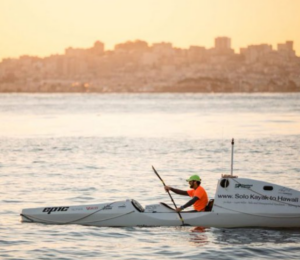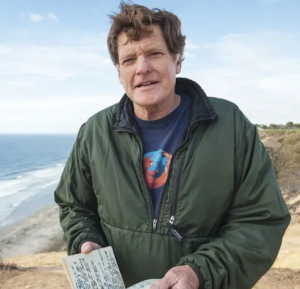Who is Ed Gillet according to Wikipedia? Information about the kayaker
#Gillet #Wikipedia #Information #kayaker
Welcome to Allsocial Updates . Get latest News related to entertainment, Education, Technology, Sports, Science , Finance at one place. Please Subscribe to our feed and Bookmark our website for all updates around the world
Who is Ed Gillet according to Wikipedia? Information about the kayaker
Ed Gillet is a well-known kayaker who has made a significant impact on the kayaking community. Kayaking has been his life since he was a little boy.
Before there were widely recognized and financially supported adventure missions, Ed had an idea that would rock the paddle universe.
In 1987, Gillet attempted a remarkable solo, unassisted, independently funded kayak paddle from Monterey, California, to Maui, Hawaii.
We consider him the greatest paddling achievement in the magazine’s 30-year history as he completed the 2,200-mile journey from his put-in.
Gillet is currently working on his high school teaching diploma, in addition to working hard to maintain his suitability for potential open ocean solos that would test his Monterey to Maui paddle.

Ed Gillet: Who is he? Biography and age
In his thirties, Ed Gillet made a name for himself by taking long kayak trips across the country. He is now in his late sixties.
Company based in San Diego In his thirties and eighties, Ed Gillet made several long kayaking expeditions. He quickly gained wide recognition as a result of people around the world.
Despite paddling 8,000 km around the Pacific coast of South America in a year, he found that kayaking along the coast wasn’t difficult enough. For example, in June 1987, Gillet set out on a solitary kayak trip from California’s Monterey Bay to Hawaii.
No one had ever paddled the 4,000 miles from the North American continent to Hawaii in a kayak, which is why his journey is known for a good cause.
In recent years, two parties have tried to fail after just one day. Even this year, while attempting a similar route in her huge, purpose-built rowboat loaded with modern equipment, Angela Madsen passed away.
Ed Gillet: Who is he?
Ed Gillet had an unimaginable concept that would tip the paddle universe from its axis before there were any well-published and heavily funded adventure missions. Gillet attempted an extraordinary solo, unsupported, self-funded kayak paddle from Monterey, California, to Maui, Hawaii in 1987. to be the greatest paddling achievement in the magazine’s 30-year history. We’ll also consider it one of the best single-sport experiences of all time, as Gillet proved Mother Nature manageable for 64 days despite her unpredictable nature. In addition to training hard to stay fit for upcoming open ocean solos that would challenge his Monterey to Maui paddle, Gillet is now aiming for his high school diploma. He took a break from his hectic schedule to discuss the trip, his plans for the future, and California’s energy problem. When did the idea for a paddle tour from California to Hawaii first occur to you? After paddling around the Pacific coast of South America for a year, I found it difficult to adjust to everyday life. I chose to paddle to Hawaii because I wanted to take on a challenge that was even more challenging and time consuming than coastal paddling could provide. I even threatened to starve, which terrified me. And because the pain of my saltwater ulcers prevented me from sleeping, I experienced a negative psychological reaction to the sleeping pill (Halcyon). Halcyon is known to cause panic attacks and sadness, something I was not aware of at the time. I experienced these symptoms, but only much later did I understand that they were caused by Halcyon. How were your favorite sea days? I was able to use my kite effectively once I found the trade winds and I started clocking 80 miles a day. The sea was a foamy royal blue, the weather was warm and I sailed with a school of mahi-mahi. They hung under my boat at night and swam next to me all day, like a pack of friendly dogs. You have done many rock and mountain climbs; what were some similarities between climbing and traveling solo from Monterey to Maui? No matches really, to use During my paddling expedition, the exposure level was constant. During the two months I was in Hawaii, I never had a chance to relax, cook a truly excellent meal, or feel comfortable. It was like hanging out in the rain on a Porta ledge for two months. Apparently they omitted such information from the booklet. Was it harder than your 4,500-mile paddle along the west coast of South America in 1984, which lasted a year? The difficulties were very diverse. There were numerous hairball landings during the South American journey over heavy waves and at night on unfamiliar beaches. There were plenty of opportunities for mistakes. I was kidnapped as a hostage once and shot twice in Peru (on the border with South Colombia). It was similar to walking a three-foot plank over a precipice when I was paddling in Hawaii; I just had to focus, stay healthy and keep going. Have you been shot at and imprisoned? What happened there? In Peru, a number of people shot at me to get my attention. That performed admirably. Then there was the time when a naval ship started shelling the hills behind the beach when I accidentally camped on a shooting range somewhere in Peru. Although the shots fell a few miles away, the situation was troubling. Of course, the artillery fire didn’t send shivers down my spine as much as it did on the Ecuador morning when several guys threw sticks of dynamite into the peaceful estuary I camped next to. I sprinted out of my tent thinking I was being attacked by a frenzied army, but they laughed. At the Colombian border, some drunken drug traffickers held me at gunpoint and dragged me to their filthy stilt village on the edge of a mangrove swamp. They kept me in custody for half a day while 20 obscene people searched my belongings for weapons or money. They seemed to believe that I was paddling on a DEA surveillance ship and that I would be carrying deadly weapons from secret agents. It turned out they hadn’t brought anything. They weren’t interested in my sloppy camping gear. What steps did you have to take each night to get the kayak ready for bed? So it took about 10 minutes to set up the pontoons. To keep the kayak in the wind and surf, I also dropped sea anchors. I imagined setting out on pontoon floats as if I were bivouacking by the ocean. Each campsite had a different atmosphere and I noted that in my diary. Sometimes I tried to remember the appearance of each location so I could quickly identify it if I ever needed to. I realize that every location on Earth has its own ghost, which may sound weird. The tracks are more discreet but still present in the ocean. I can understand how disturbing it was to sleep under the tarp for the first time. Have you ever experienced anxiety or claustrophobia? The tarp was actually a last minute attempt to keep the water out, and it didn’t work very well. To make the lid go over the cockpit, I had one made. The lid was claustrophobic and unusable at sea; it was scary. Although it sounds absurd, I forgot to try it out on the water before going. The answer would have been to build a dodger, the sailboat equivalent of a tent. This is a strange subject, but how did you deal with some of the bodily discharges? Just hang over the side of the boat, if you like. What’s the problem? No problems at all, people who spend their time outside always have to find new ways – and maybe new locations – to relieve themselves. This was undoubtedly different in both setting and manner. Simply put, balancing the boat must have been a pain in the butt.
Husband of Ed Gillet
Ed Gillet and Katie Kampe had a happy marriage. While kayaking in Sausalito in October 1985, Gillet had a moment of love at first sight with her.
He first saw a 20-foot yellow Tofino sea kayak made by Mike Neckar, a craftsman of Czech descent, when he met professional rower and future wife Katie Kampe of the Bay Area.
In 1986, Kampe moved to San Diego to live with Gillet. She ran a small rowing operation near Shelter Island while he went kayaking on group outings to pay for the Tofino and other gear for his expedition.
A few months before his adventure, they married in Torrey Pines State Park. They also founded a new Southwest Kayaks company.
Gillet claimed that his wife, an accomplished sailor and adventurer whose father held the rank of colonel in the army with a silver star, gave him the drive and encouragement he needed to be successful.


The career of Ed Gillet
Ed Gillet has pursued his love despite the fact that his kayaking income may not be very high. This is his favorite activity.
When Gillet felt intimidated by the sheer number of miles ahead, he would stop and eat. By focusing on every bite of his meal, he was able to think and be in the present.
When his food supply ran out, he was lucky enough to occasionally catch mahi-mahi from a school that followed his kayak for hundreds of miles. He eventually lowered his calorie intake to 500 a day, started eating toothpaste, and went out of food after 60 days.
Although he was 19 days late, Gillet expected to see his family waiting ashore. He was unaware that the beacon was defective and they had no idea where he was or even if he was still alive.
He then landed the kayak, called his family from a nearby hotel lobby, bought $22 worth of ice cream and snacks, and then found a spot under a tree to enjoy the moment.
Gillet, a lifelong teacher at a nearby high school, claimed he was silent for more than 25 years after growing tired of the misconceptions and media frenzy that surrounded his trip.
Quick Facts
| First and last name | Ed Gillet |
| Profession | kayaker |
| Age | about 70 years old |
| Female | Katie Kampe |
